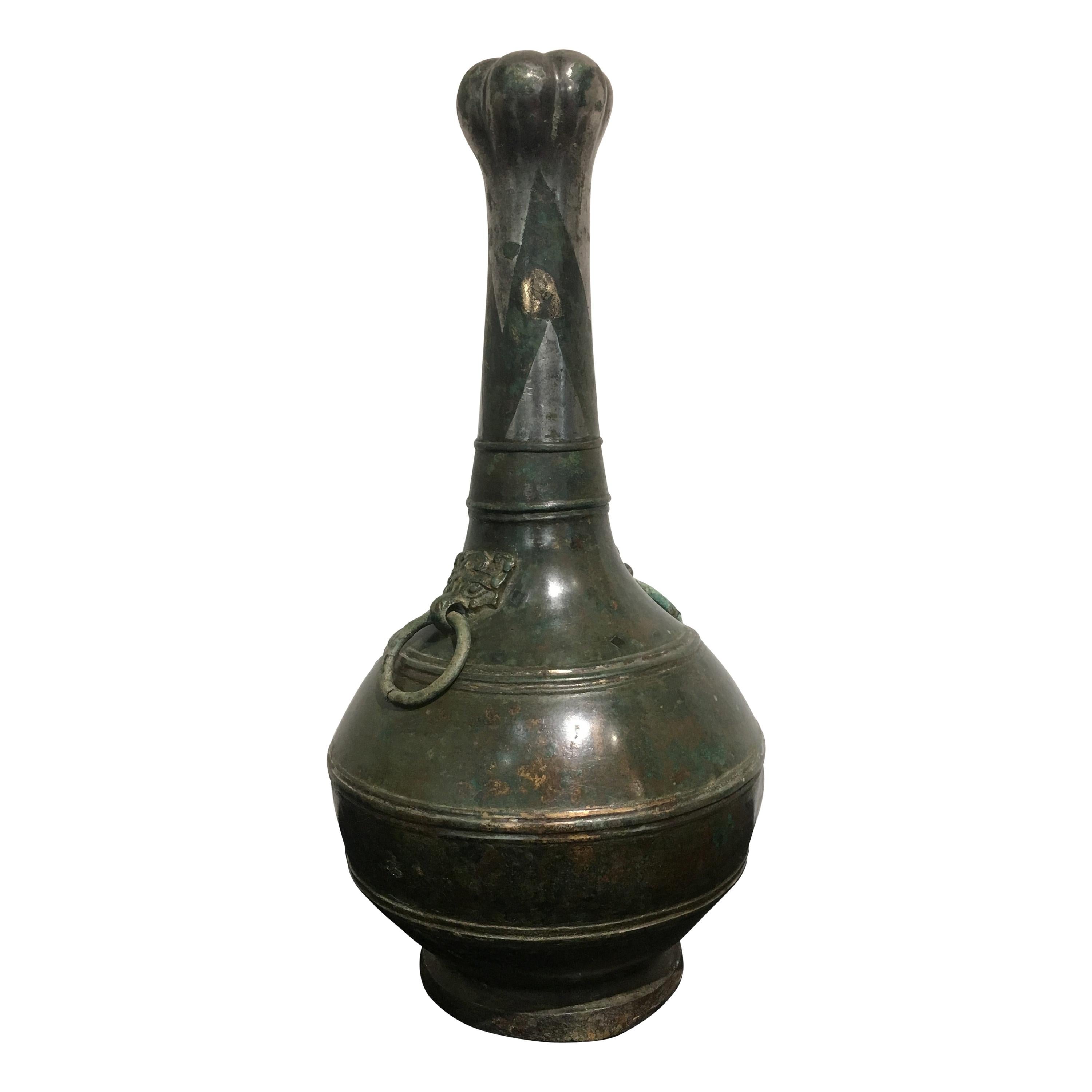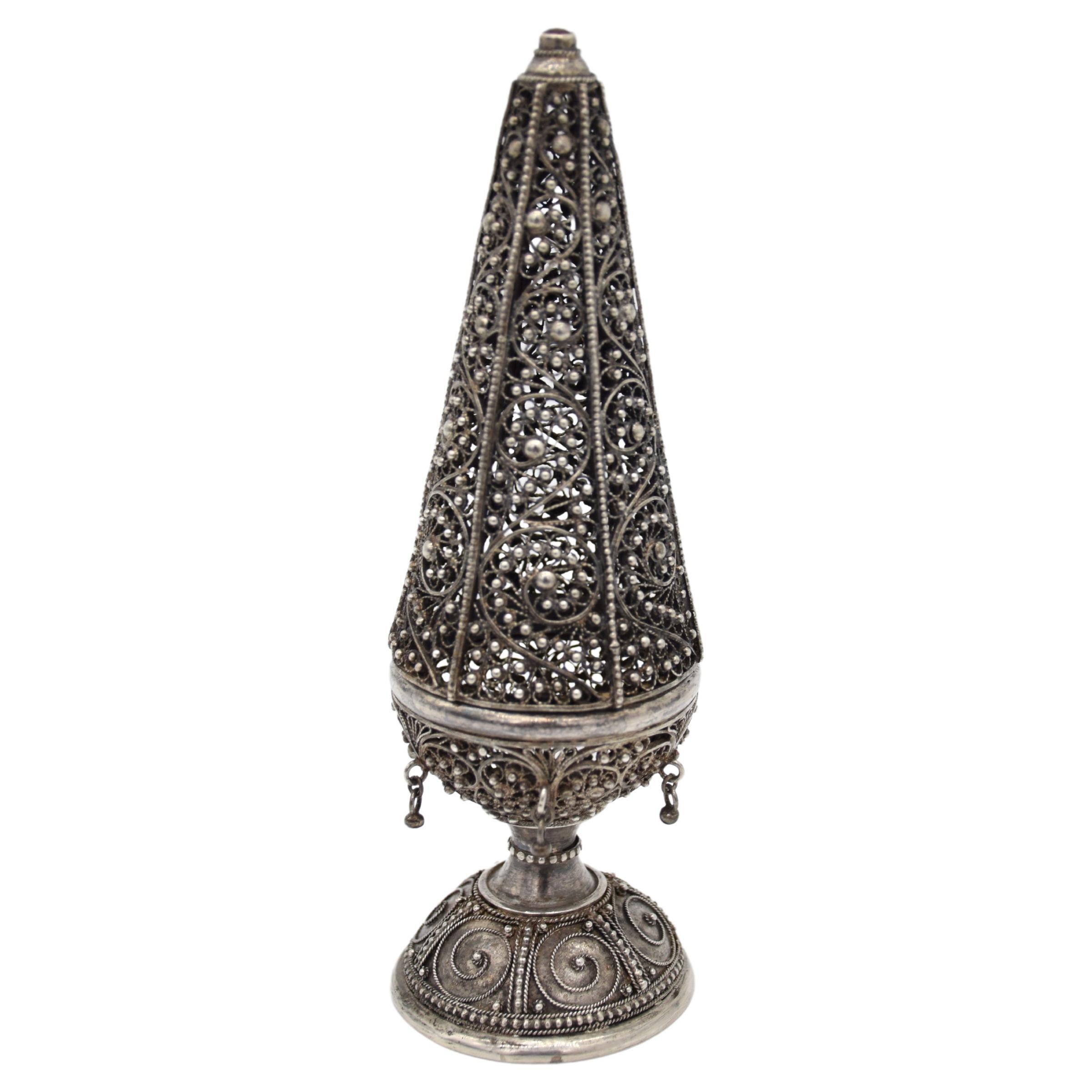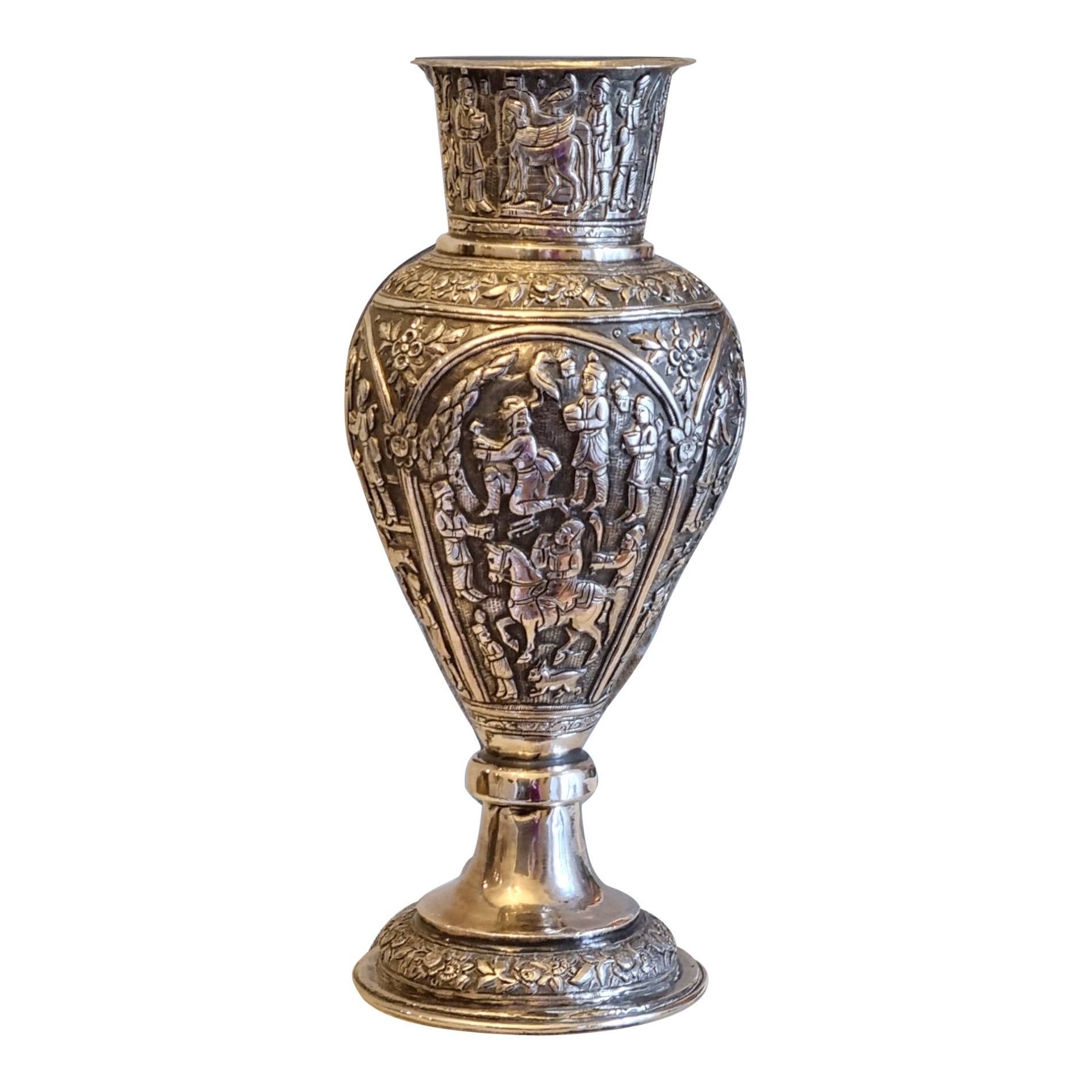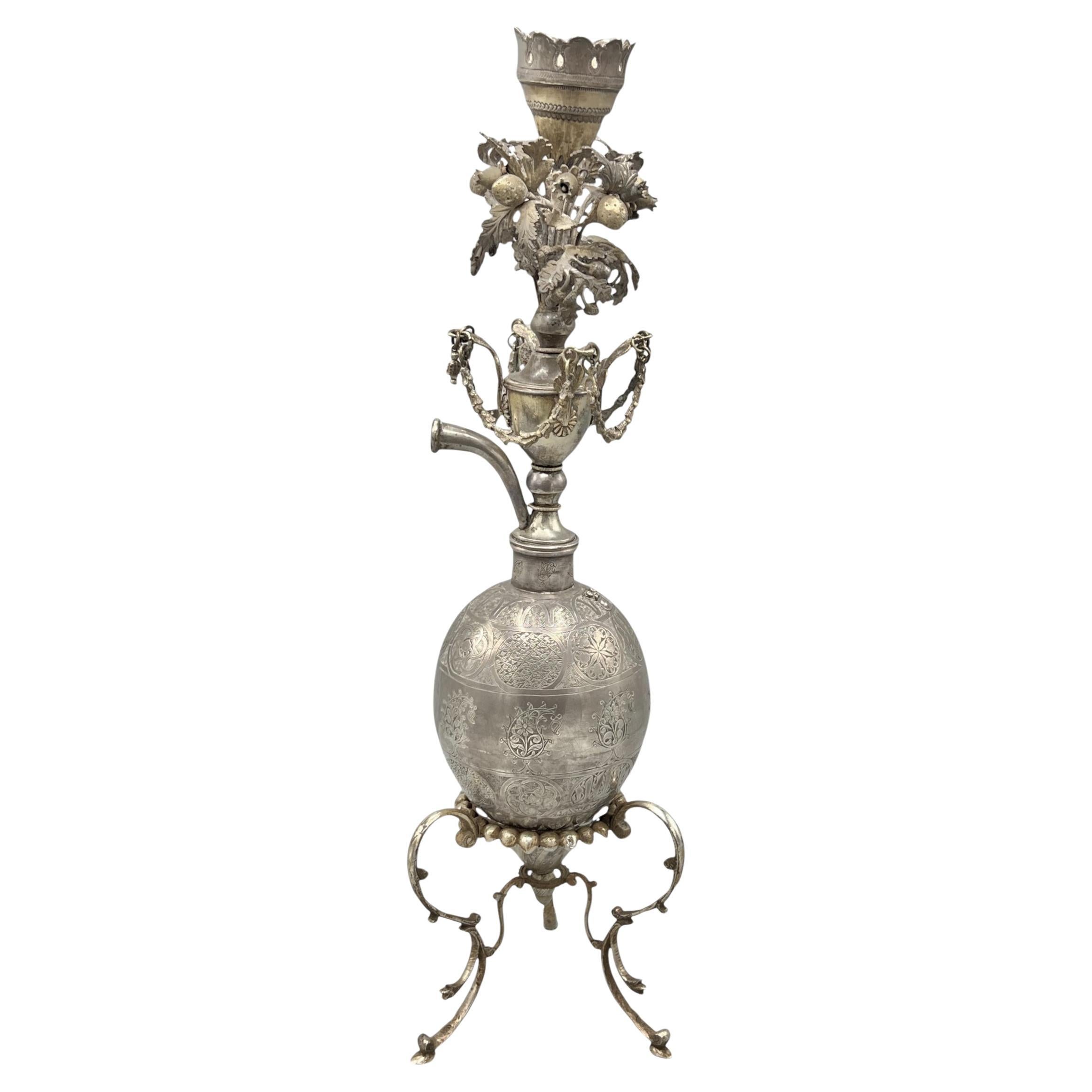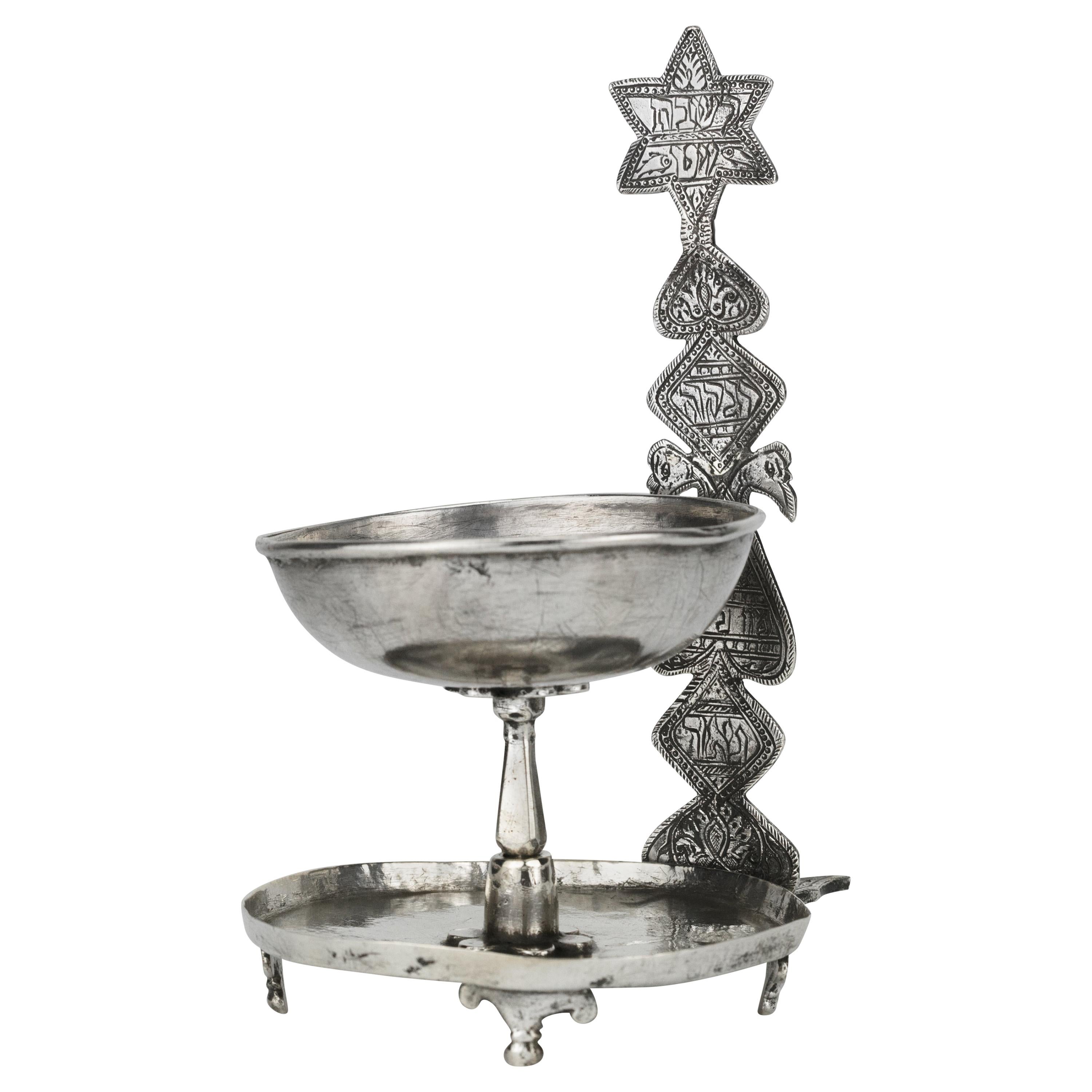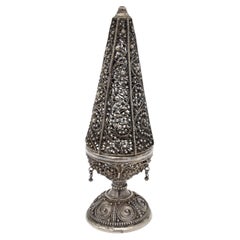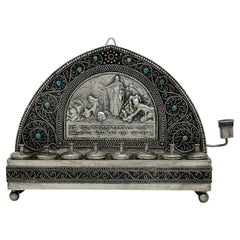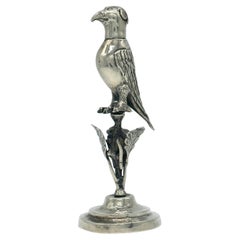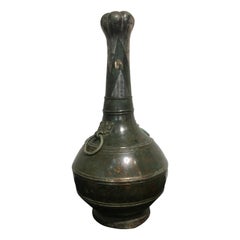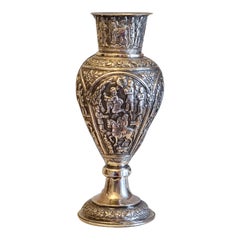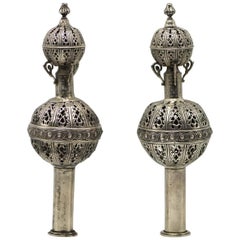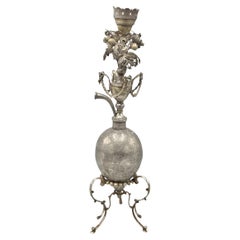Items Similar to Rare silver Tantur or Druze head ornament, hand made, Lebanon 18th century
Want more images or videos?
Request additional images or videos from the seller
1 of 21
Rare silver Tantur or Druze head ornament, hand made, Lebanon 18th century
$25,000
£18,948.57
€21,934.82
CA$35,293.50
A$39,302.13
CHF 20,520.54
MX$476,218.14
NOK 258,785.68
SEK 244,184.69
DKK 163,740.86
About the Item
up for sale is This rare and important item known as a Tantur, made from silver in the 18th century. This conical headdress was worn by Druze and some Maronite women in the mountain regions of Lebanon or Syria ,It is tall, conical, and made of engraved, high-grade silver. It tapers to a top that is slightly curved and engraved with a flower motif. the quality of work and diversity of flowers and animals on it is just remarkable, it’s also very rare to find one with an Arabic inscription that reads "work of Michael Nakach" its very interesting g that The Nakach last name is believed to be of Jewish origin, with potential roots in Arabic and Hebrew languages. It is likely a variation of names like Nakash or Nakkach and can be connected to words meaning "to hiss" or "to engrave/carve," suggesting a possible ancestral connection to artisans skilled in engraving. such a cross cultural object, made for use of Druze women but made by a jewish silversmith in an islamic country.
The sides are engraved with floral designs, fish/birds/snakes and a lot of flowers and tree shaped plants, the middle part has a two line inscription in Arabic , and bands of geometric and wavy patterns. The lower rim has two studs with rings to allow the headdress to be secured to the head.
Married women wore the tantur on the top of their heads and often with a silk or muslin scarf or veil over the structure which fell to the shoulders, (look at the last picture) Higher ranked women wore a silver or gold tantur, and those of the lowest ranks wore tanturs made from wood or copper.
Visitors to the mountainous regions of Lebanon reported towards the end of the 18th century they see unicorn shaped headdress, the tanturs would be presented by their husbands on their wedding days and that the women who wore tanturs almost never took them off other than to sleep.
The interesting part in this tantrums is that the base has a silver stripe with an inscription stating it was a prize for the 1st place in an archery competition “1st Prize to Sir Walter Carew, August. 24th 1848”, we dont know why they choose to give it in an archery competition as a trophy, probably its shaped reminded them of an arrow quiver.
We think the inscription is important because it’s a good dating provenance for this item.
Objects as this important artifact were melted down and lost in time, the culture of wearing this heats was lost at around 1850-1860 so only the examples that went to europe survived, this item is a museum quality piece, worthy to any important collection or ethnographic museum, and the later english inscription gives this piece a truly important and interesting provenance.
Some more examples known in museums around the world including the British Museum, the Pitt Rivers Museum at the University of Oxford and more.
Sizes :
Height : 40 cm / 15.7 inch
Width : 7.5 cm / 2.9 inch.
- Dimensions:Height: 15.7 in (39.88 cm)Diameter: 2.9 in (7.37 cm)
- Materials and Techniques:
- Place of Origin:Lebanon
- Period:
- Date of Manufacture:1780
- Condition:Repaired: there are 6 spots of old repair in small holes as you can see in photos, plus 2 open holes. but the structor is stable and good. Wear consistent with age and use. Condition is generally good despite some wear, dings, scratches and old repairs. the top has some old repair marks, there are 6 spots of old repair in small holes as you can see in photos, plus 2 open holes. but the structor is stable and good.
- Seller Location:Tel Aviv - Jaffa, IL
- Reference Number:1stDibs: LU8130246404852
About the Seller
No Reviews Yet
Vetted Professional Seller
Every seller passes strict standards for authenticity and reliability
1stDibs seller since 2023
- ShippingRetrieving quote...Shipping from: Tel Aviv - Jaffa, Israel
- Return Policy
Authenticity Guarantee
In the unlikely event there’s an issue with an item’s authenticity, contact us within 1 year for a full refund. DetailsMoney-Back Guarantee
If your item is not as described, is damaged in transit, or does not arrive, contact us within 7 days for a full refund. Details24-Hour Cancellation
You have a 24-hour grace period in which to reconsider your purchase, with no questions asked.Vetted Professional Sellers
Our world-class sellers must adhere to strict standards for service and quality, maintaining the integrity of our listings.Price-Match Guarantee
If you find that a seller listed the same item for a lower price elsewhere, we’ll match it.Trusted Global Delivery
Our best-in-class carrier network provides specialized shipping options worldwide, including custom delivery.More From This Seller
View AllEarly 20th Century Silver Spice Tower by Yehia Yemini, Bezalel School Jerusalem
Located in Tel Aviv - Jaffa, IL
Very rare Bezalel Jerusalem silver filigree spice tower, this amazing spice Tower was Made by Yehia Yemini, who was the best filigree artist in bezal...
Category
Vintage 1920s Israeli Sterling Silver
Materials
Silver
Bezalel Jerusalem silver Hanukah lamp set with stones, Yehia Yemini circa 1920s
Located in Tel Aviv - Jaffa, IL
A Silver Hanukkah lamp crafted by Yehia Yemini in Jerusalem circa 1920 is a fascinating piece of Judaica. Yehia Yemini was known for his intricate and detailed silverwork. This lamp ...
Category
Vintage 1920s Candle Lamps
Materials
Multi-gemstone, Sterling Silver
Important 18th century Persian Jewish silver Amulet for mother and newborn
Located in Tel Aviv - Jaffa, IL
Mysterious Amazing, 18th century silver talismanic amulet, Amulet for mother and Newborn with image of Lilith in the center made by Jews in Persia, the top of the Amulet has an amazi...
Category
Antique 1790s Tribal Art
Materials
Agate, Silver
RARE Austrian silver (ALT WIEN) Havdalah spice container, Judaica ISRAEL MUSEUM
Located in Tel Aviv - Jaffa, IL
Up for sale is this museum quality Judaica Havdalah spice container, very rare with great provenance!!
This silver spice tower was made in Vienna Austria, on the early part of the 19...
Category
Antique Early 1800s Snuff Boxes and Tobacco Boxes
Materials
Silver
extremely rare Algerian Judaica silver, jewish Dowry box early 19th century
Located in Tel Aviv - Jaffa, IL
Amazing and scarce JUDAICA object, we have here one of the most touching jewish objects we had for a long time, this small silver dowry box was made in Algeria in the early 19th century, it is all covered with symbols of jewish faith and of couples, the sliding lid has 2 flanking birds with hamsa (protective hand) on each side and a flower vase in the middle.
one side shows two flanking lions with a tree in the middle and the other side shows again two big and two small birds with a flower bowl in the middle, front side has a key hole and next to it there is the Hebrew inscription ס״ט״" which says Siman tov or in English "a good sign" it is taken from the wedding blessing, underneath the lock there is another inscription with the name ״עזיזה בת אברהם בן חמו״ which is the name of the bride, her father and her grandfathers name.
the box is full marked a lot of times with the silversmith mark, every side of the box is marked.
this box was probably ordered by the grooms family to hold the jewelry they are giving to the bride as dowry, this type of objects are rare and there are just a few of them on museum collections.
DOWRY (Heb. נְדֻנְיָה), the property a wife brings to her husband at marriage; the Yiddish equivalent, nadn, is from the same root. The custom of nedunyah became clearly defined and institutionalized only in the talmudic period. In biblical times, mohar (מֹהַר), whereby the groom bought his wife from her father (Gen. 24:53; Ex. 22:15–16; Hos. 3:2), was the accepted practice. It was then customary that the groom give the bride gifts, and that she bring certain property to her husband's home upon marriage: slaves, cattle, real estate, etc. (cf. Gen. 24:59–61; 29; Judg. 1:14ff.; I Kings 9:16). Evidence of the custom of nedunyah is to be found in Tobit (7:14; 8:21) and in the Assuan papyri (Cowley, Aramaic, nos. 15, 18). Gradually, mohar was superseded by the ketubbah custom according to which the husband merely assumed the responsibility of compensation to his wife in case he divorced her: he had to pay her 200 zuzim if she had been a virgin at the time of marriage, and 100 zuzim if a widow or divorcée (see *Ketubbah).
By talmudic times, the institution of nedunyah was prevalent; the father gave a dowry to the bride since the daughter was excluded from paternal inheritance. Fifty zuzim (equivalent to the worth of 180 grams of silver) was the minimum amount a father was obliged to give to his daughter (Ket. 6:5). Parents usually gave much more, according to their social standing. Community funds provided the dowry for an orphan or a very poor girl (ibid.; cf. Sh. Ar., YD 251:8). In case of her father's death, the brothers of a minor girl were obliged to give her the minimum dowry, and the court estimated how much her father would have given her above the minimum dowry. The sum was then taken out of the father's estate and given to the daughter upon majority (Ket. 6:6; 68a–69b). In the absence of such an estimate, each daughter was entitled to receive one-tenth of the value of her father's estate in money, or in valuables (Yad, Ishut, 20:4–7; Sh. Ar., EH 113:4). If the father was unable or unwilling to pay the promised dowry at the betrothal ceremony, the groom could refuse to marry his bride (Ket. 13:5; Ket. 108b–109a). Insistence on exact payment of the promised dowry, however, was frowned upon by later rabbinic authorities (Rema to Sh. Ar., EH 2:1). In certain communities it was customary for the groom's father to make a dowry contribution equal to that of the bride's father (Ket. 102b). The dowry, whether given in real estate, slaves, money, or chattel was recorded in the marriage contract (the ketubbah) and in some instances one-third or one-fifth of the actual value of the dowry was added to the sum mentioned in the ketubbah. Based upon a decree enacted by *Simeon b. Shetah (first century C.E.), the Talmud ruled that the husband and his entire property were liable for compensation as stipulated in the ketubbah, either in case he died (when she collected the sum specified in the ketubbah from the heirs) or in case he divorced his wife (Ket. 82b). For the status of the dowry and the husband's rights and obligations, see below. The rabbinic enactments (Takkanot Shum) by R. Jacob *Tam and by the rabbinic synod of the communities of Speyer, Worms, and Mainz (Germany) stipulated that if a woman died...
Category
Antique Mid-19th Century Algerian Tribal Art
Materials
Silver
Early German Silver Augsburg Baroque Spice Tower, Hans Jacob Ernst , circa 169
Located in Tel Aviv - Jaffa, IL
One of the earliest spice towers we could find, it is very rare to see judaica
from the 17th century, and this 1690s spice tower is super scarce, a true gem of Baroque silver and ba...
Category
Antique 1690s Sterling Silver
Materials
Silver
You May Also Like
Chinese Han Dynasty Silver-Decorated Garlic Head Bronze Hu Vase, 3rd Century BC
Located in Austin, TX
A gorgeous and striking late Warring States (475 to 221 BC) or early Han Dynasty (221 to 206 BC) cast bronze and silver-decorated garlic head hu vessel.
Of elegant bottle form, w...
Category
Antique 15th Century and Earlier Chinese Han Antiquities
Materials
Bronze
Antique Persian Zoroastrian Parsi Parsee "Muktad" Silver Vase, 1900
Located in OVIEDO, AS
PERSIAN Zoroastrian Parsi Parsee "Muktad" Silver Vase Ca. 1900
Chased in a Shiraz-Persian style (a linkage back to the Parsees’ Zoroastrian roots in Persia). This beautiful vase from the Qajar Dynasty era (1785 to 1925) is originated in Shiraz, a southwest city in Persia and the home of the Achaemenid Persian Empire founded in the 6th century BCE by Cyrus the Great...
Category
Early 20th Century Persian Vases
Materials
Silver
Mid-19th Century French Silver Torah Finials 'Rimmonim'
Located in New York, NY
Handmade silver Torah finials, chased, pierced, engraved, and cast, France, circa 1860.
The finials are constructed with large open-work decorated ball ...
Category
Antique Mid-19th Century French Religious Items
Materials
Silver
$9,260 Sale Price
27% Off
19th Century Ottoman / Turkish Silver Huqqa / Hookah
Located in New York, NY
Antique (19th century) huqqa (hookah) finely crafted from silver, of ovoid form resting on three-legged stand with floral designs around the neck and embossed designs throughout. 20...
Category
Antique Late 19th Century Turkish Tobacco Accessories
Materials
Silver
19th Century Afghan Silver Shabbat Oil Lamp
Located in New York, NY
Silver Sabbath oil lamp, Afghanistan, late 19th century.
Featuring a rimmed bowl elevated on a paneled stem, with larger drip pan below, resting on three feet. Extended piece of han...
Category
Antique Late 19th Century Afghan Religious Items
Materials
Silver
$6,240 Sale Price
26% Off
Early 20th Century Silver Spice Tower by Bezalel School Jerusalem
Located in New York, NY
Silver and silver filigree spice container, Jerusalem, circa 1920.
Ball spice container raised on a stem, On a round decorated base with fili...
Category
Early 20th Century Israeli Religious Items
Materials
Silver
$1,040 Sale Price
20% Off
